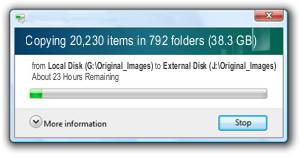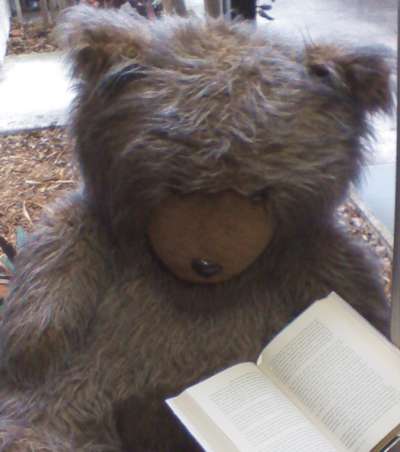
Monthly Archives: April 2013
“23 Hours Remaining”
Warning: Tech joke ahead.
“I’ve gotten FAT.”
OK, that’s not exactly true, since I’m on NTFS and haven’t used FAT for years but I do have a lot of files.
I don’t make a living at photography but I do shoot to sell and that means I have what we call in the trade a “lot of shutter actuations.”
Three of my cameras since the 1980s really stand out: a Canon A-1, a Kodak DC-4800, and the new Canon 6D. Two of those are digital and I’ve scanned at least some of the film I shot before the turn of the Century.
That means my hard disk has gotten fat.
Every new photo from the new camera makes a 21MB file.
Some of those older photos are snapshots. Nice memories. Good for the refrigerator door. Not something I’ll put in a frame in the gallery. The rest are artistic or commercial.
I have probably 4,700 snapshots (there are about 10GB in 9,300 files) shot through 2000. The 3,800 images for printing or show from 2001-11 take another 16.7GB on the drive. I’ve never used 96% of those but I mean to.
2,127 shots in the 12 weeks since I bought the new camera, and another 300 keepers (576 files) out of those for 8.3GB. I’m ‘shopping and printing a far higher percentage of the originals than I did with any of the other cameras.
Assuming I might realistically keep 1,000 photos/year and print 200 of them, I’ll need 30 or 35 GB of new file storage each year just for gallery photos. That’s not as bad as I first thought but it’s still a lot to fit on my local drive so I went looking for online storage.
Google charges $0.085/GB/month for the first 0-1 TB which doesn’t sound like much until you multiply it by 12,000. Dropbox has an annual fee of $500 (OK, $499) for ½ TB.
Hmmm. Justcloud.com (something I’d never heard of), Backblaze (ditto) and a couple of others are under $50/year for unlimited storage with file versioning and more stars in reliability than Sugarsync or Carbonite.
Meanwhile, I ordered a 2 TB external drive because I need room for my next shoot. I did that because I still haven’t figured out how to install a non-RAID second drive in the second drive bay on my laptop. I’d RTM if Lenovo would give me one. I spent a while googling for one and nada.
The FedEx guy snuck the new drive onto the porch the very next day.
It’s amazing how 2 TB appears to fit in the same size box that used to hold 2 MB. The Quick Start guide has three pictures: one of de stuff in de box. One showing how to plug the wall wart into the wall and the drive. One showing the USB cable going into the drive and the computer.
I started copying files. Gonna take a long time.

Copying 20,230 items in 792 folders (38.3 GB)
from Local Disk (G:\Original_Images) to External Disk (J:\Original_Images)
About 23 Hours Remaining
It turns out 22,163 (56GB) in image files of various descriptions transferred overnight the first night. 2,125 are in the dodged-and-burned-and-ready-to-sell category and the rest are originals.
This is becoming a gallery problem as well. About 180 of my fine art photos have moved over to the gallery.northpuffin.com site so far. I could have ten times that many online by the end of the year and that’s simply too too many for visitors (and buyers) to process.
The new camera can shoot production quality, HD video. I dunno what I’ll do if I start shooting video but I think my new hard drive will disown me.
Rainy Day in the Keys
Wordless Wednesday
Scientific Art Show
The Bent-Northrop Memorial Library of Fairfield, Vermont, will debut a three-person statewide art tour on Monday at 6 p.m. after the library has closed. The Brain-to-Brain Art Download Tour has additional stops planned at other libraries around the state.
Three Franklin County artists will participate: musician Jeff Blouin of Neon Spoon, painter and iPhone photographer Paule Gingras of St. Albans, and writer and former CTV Anchor Bill Haugland of Highgate Springs. Each will have a new work available for brain-to-brain download.
The art is in the work. The science — and the show — come from the download.
Brain-to-brain interfaces have arrived for reading, music, or art. Thanks to researchers at UVM, it will soon be commercially possible to download a virtual story from the author’s brain, a painting from an artist, or a song from a musician. Don’t forget to leave an actual cash payment.
Here’s how it works. Multiple electrodes placed on the artist’s scalp record activity from the artist’s cerebral cortex and convert it into an electrical signal that is delivered via neural link to another set of electrodes on an exhibit visitor. The attendee’s brain processes the signal from the artist and — despite being unfamiliar with the work the artist has performed — gains total recall of the piece. And, thanks to a new smartphone app, the artist and viewer will soon be in different locations.
“This is mind-blowing,” UVM neuroscientist Bernard Schwartz said.
Dr. Schwartz and his colleagues built on an experiment led by Duke neuroscientist Miguel Nicolelis, a pioneer in the field of brain-machine interfaces. In that 2008 work, Dr. Nicolelis implanted a monkey with a new brain-computer interface. The monkey controlled a robot walking on a treadmill in Kyoto, Japan. The monkey watched the robot walking in sync with him by way of a display screen.
A new experiment reported this year showed brain to brain communication between rats, one in Natal, Brazil, and one at Duke in North Carolina using similar brain-computer interfaces. In that experiment, the “encoder” rat in Brazil learned to press a lever in its cage. The brain implant recorded activity from the rat’s motor cortex and converted it into an electrical signal delivered via neural link to the brain implant of a second “decoder” rat.
It was a simple step to human artists.
“Artists are in this respect easier to work with,” Dr. Schwartz said. “Because they can visualize an entire work at one time.”
Each artist will download just three times to “mind-melders” in the library gallery.
“Why not have ’em put together a medley of earworm songs!” Bent-Northrop’s Wendy Maquera asked. “I wonder which one would stick?” We went to my Interweb friends to work up a set list that included All the Single Ladies, Call Me Maybe, Jenny (867-5309), Old Time Rock and Roll, Pinball Wizard, Take a Letter, Maria, Tubthumping and Never Gonna Give You Up (with an over-saturated Spoony doing the video dance moves) plus George Thorogood’s Bad to the Bone and I Drink Alone, and a famed horror writer’s suggestion of Bach’s Concerto for Two Violins in D Minor or Tuvan throat-singing.
Mr. Blouin has worked out a new the Gregorian Chant that he “guarantees will plant an earworm.” His rendition of Celine Dion’s My Heart Will Go On includes the score and lyrics.
Ms. Gingras “shares the beauty people walk by and never notice” with her iPhone photos. Her piece for this show blends technology with her Franklin County landscape.
After It Rains, Mr. Haugland’s new book of short stories, is coming out in June. He will spin The Photograph for this show. “I’m intrigued that even a dinosaur with technology can simply think about a picture and put the entire story in someone’s head,” he said, “so I’m game.”
The rat study was published in Scientific Reports in January; Dr. Schwartz plans to publish later this year. Apple and Google have already expressed interest in the technology.
Tickets, schedules, and downloadable background materials are available at ticketmaster.allarts.org. Admission is FREE but you must have an advance reservation to participate. Proceeds will benefit local art projects in Franklin County, Vermont.


